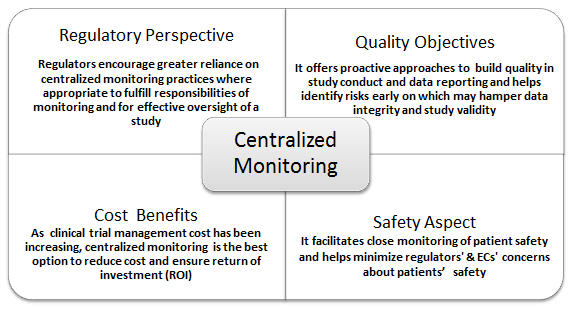Centralized Monitoring: Sooner Is Better

By Ashok Ghone, Ph.D., VP, Global Services, MakroCare USA
The increased complexities of clinical trials in the last few years have created new challenges which require better monitoring and increased oversight to ensure higher quality conduct and better monitoring of patient safety. At the same time, the cost of clinical trial management has been increasing steadily, and clinical R & D is also facing budget constraints. Considering the benefits that centralized monitoring offers in terms of quality, safety monitoring, and cost, many biopharmaceutical and medical device companies have already adopted a centralized monitoring approach in the practice, and many are on the verge of implementing it.
Why is centralized monitoring going to be the preferred, smarter, and cost-effective complementary or alternative approach to traditional monitoring?

Regulatory Perspective: FDA has provided recommendations regarding monitoring practices in the guidance document “Oversight of Clinical Investigations – A Risk- Based Approach to monitoring” and encourages sponsors to consider changing their approach to monitoring. With a proper risk based approach, appropriate use of centralized monitoring and reliance on technology advances can help to meet statutory and regulatory requirements. FDA encourages greater reliance on centralized monitoring wherever appropriate, as it provides many of the capabilities of on-site monitoring as well as additional capabilities. The growing interest in e-clinical systems and innovations in clinical trial management offer alternative and complementary approaches like centralized monitoring that improve the quality and efficiencies of sponsor oversight of clinical trial conduct. The majority of on-site monitoring findings and certain quality issues may be more readily detected by a centralized monitoring approach than on-site monitoring.
Quality Objectives: There are several advantages to choosing centralized monitoring. Not only can you closely monitor the quality of the study and the data, but it also helps to reduce the frequency and extent of on-site monitoring and increase the effectiveness of on-site visits. Centralized monitoring can help:
- identify risks to clinical data early, ensure completeness and consistency of data, and perform standard checks to highlight unusual distribution of data
- identify the protocol deviations/violations, data trending, outliers, and potential errors/issues in study conduct and reporting by applying appropriate statistical analysis
- categorize higher-risk clinical sites (e.g. sites with data anomalies or higher frequency of errors, protocol deviations/violations, high screening failure, or drop-out rate, etc.)
- conduct analyses of the critical data to identify issues and sites with poor performance and non-compliance
- verify source data (SDV) whenever possible as per the monitoring plan
Safety: Patient safety and wellbeing are the important parts of a clinical trial and are also critical to ensure compliance to study protocol and ICH-GCP regulations. Centralized monitoring enables close monitoring of patient safety. Using safety data and with the help of proper analytics, centralized monitoring helps in understanding AE/SAE trending, distribution, and outliers. It also facilitates identification of study or site specific issue which requires immediate attention to protect subjects’ well being. Centralized monitoring provides better insight on safety trends, which is not possible with on-site monitoring, and it also helps to understand site- specific issues or non-compliance.
Cost Benefits: In clinical trial management, on-site clinical monitoring accounts for around one third of the overall cost. One of the benefits of centralized monitoring is to minimize or optimize on-site visits by identifying risks/issues proactively and by keeping track of site performances. The issues identified during centralized monitoring which need to be addressed during monitoring visits are proactively communicated to the onsite CRAs, thereby increasing the effectiveness of on-site CRAs by helping them use their time efficiently and objectively during on-site visits.
Centralized monitoring offers a smarter and more cost-effective way to enhance quality and monitor patient safety in an efficient manner. So far, few sponsors have started implementing centralized monitoring into practice, and others are waiting to gain more confidence in the process as it involves changes in management, process restructuring, and training of resources. However, as regulators support the use of centralized monitoring appropriately to improve quality and efficiency of sponsor oversight, sooner adoption of a centralized monitoring approach would be beneficial and could lead to better ROI.
Ashok Ghone, Ph.D. is VP, Global Services at MakroCare USA. He has around 20 years of experience in the pharmaceutical and clinical research industry. Ashok has good knowledge and understanding of global clinical research with hands-on experience in clinical operations, project management, clinical trial management, process development, site management, and patient recruitment activities. He has led various cross-functional teams successfully by providing strategic direction and guidance for accomplishment of local, regional and global projects involving early and late phase clinical studies in various therapeutic areas. Ashok has been involved in development of process, system, and training related to risk-based monitoring and centralized monitoring at MakroCare, which offers these specialized services to biopharmaceutical and medical device companies to support their endeavors in implementation of the RBM, Centralized Monitoring approach.
